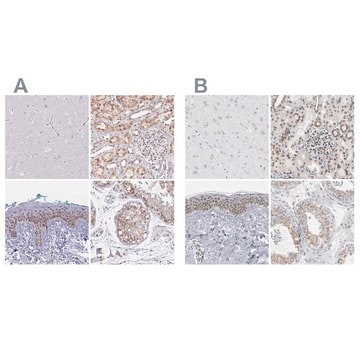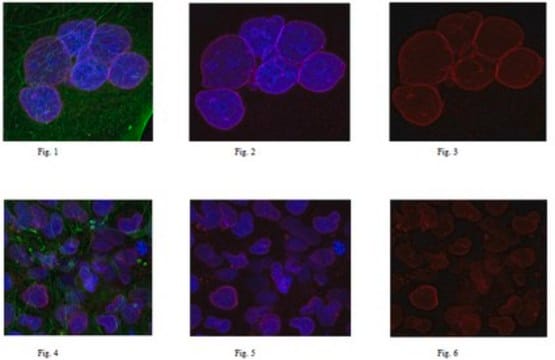ABN2288
Anti-Nesprin-2/SYNE2
Sinônimo(s):
KASH domain-containing protein 2, KASH2, Nuclear envelope spectrin repeat protein 2, Nucleus and actin connecting element protein, Protein NUANCE, Synaptic nuclear envelope protein 2, Syne-2
About This Item
Produtos recomendados
fonte biológica
rabbit
Nível de qualidade
forma do anticorpo
purified antibody
tipo de produto de anticorpo
primary antibodies
clone
N/A, polyclonal
peso molecular
calculated mol wt 782.75 kDa
observed mol wt ~135 kDa
reatividade de espécies
mouse
reatividade da espécie (prevista por homologia)
canine
embalagem
antibody small pack of 100 μL
técnica(s)
immunocytochemistry: suitable
western blot: suitable
Isotipo
IgG
sequência de epítopo
N-terminal
nº de adesão de ID de proteína
nº de adesão UniProt
temperatura de armazenamento
-10 to -25°C
Informações sobre genes
mouse ... Syne2(319565)
Descrição geral
Especificidade
Imunogênio
Aplicação
Evaluated by Immunocytochemistry in NIH3T3 cells.
Immunocytochemistry Analysis: A 1:1,000 dilution of this antibody detected Nesprin-2/SYNE2 in NIH3T3 cells.
Tested applications
Western Blotting Analysis: A representative lot detected Nesprin-2/SYNE2 in Western Blotting application (Luxton, G.W., et. al. (2010). Science. 329(5994); 956-9).
Western Blotting Analysis: A 1:1,000 dilution from a representative lot detected Nesprin-2/SYNE2 in NIH-3T3 overexpressing Nesprin-2.
Immunocytochemistry Analysis: A representative lot detected Nesprin-2/SYNE2 in immunocytochemistry application (Zhang, Q., et. al. (2019). Curr Biol. 29(17); 2826-2839).
Note: Actual optimal working dilutions must be determined by end user as specimens, and experimental conditions may vary with the end user.
forma física
Armazenamento e estabilidade
Outras notas
Exoneração de responsabilidade
Not finding the right product?
Try our Ferramenta de seleção de produtos.
Código de classe de armazenamento
11 - Combustible Solids
Classe de risco de água (WGK)
WGK 1
Ponto de fulgor (°F)
Not applicable
Ponto de fulgor (°C)
Not applicable
Certificados de análise (COA)
Busque Certificados de análise (COA) digitando o Número do Lote do produto. Os números de lote e remessa podem ser encontrados no rótulo de um produto após a palavra “Lot” ou “Batch”.
Já possui este produto?
Encontre a documentação dos produtos que você adquiriu recentemente na biblioteca de documentos.
Nossa equipe de cientistas tem experiência em todas as áreas de pesquisa, incluindo Life Sciences, ciência de materiais, síntese química, cromatografia, química analítica e muitas outras.
Entre em contato com a assistência técnica








